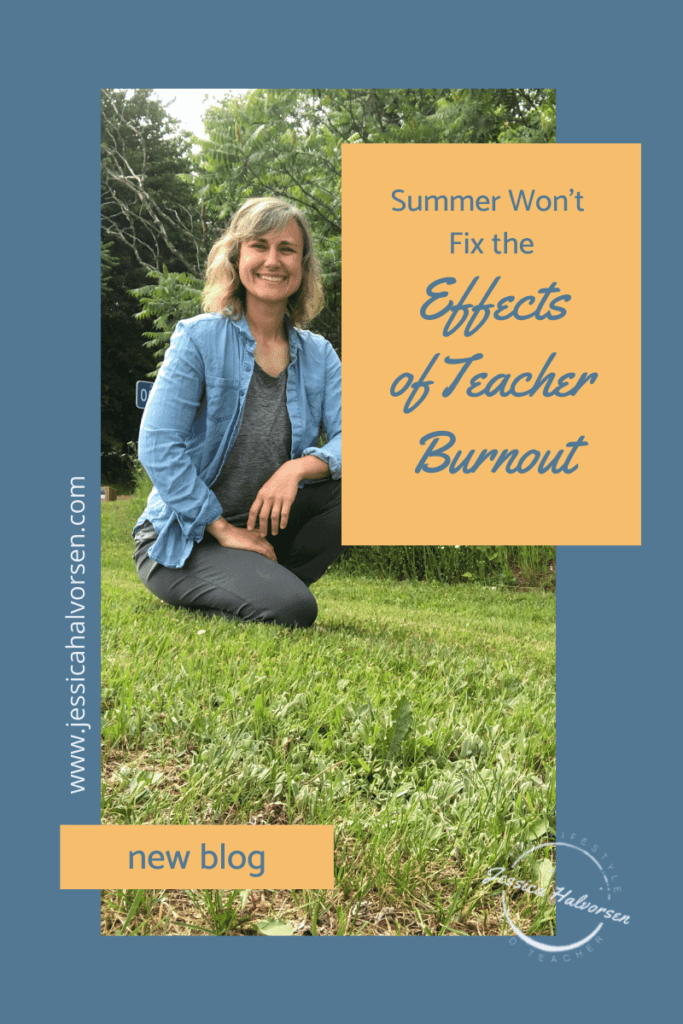As the school year winds down and summer break approaches, many educators long for a much-needed reprieve from the demanding teaching world. However, amidst the excitement of vacations and relaxation, addressing the persistent issue of the effects of teacher burnout is vital.
If you experience the effects of teacher burnout due to overtime hours during the school year, I’m here to help with this guide, the 5 Teacher Time Management Secrets to Leave Work at Work. Summer may provide a temporary respite, but it is unlikely to be the cure-all for the long-term effects of this prevalent problem. You can download your FREE copy here.

The Effects of Teacher Burnout
Teacher burnout is complex and affects educators on multiple levels. It goes beyond feeling tired or stressed; it encompasses emotional, physical, and mental exhaustion.
Teachers experiencing burnout often feel disillusioned, detached, and ineffective in their roles. The demanding nature of the profession, including long work hours, heavy workloads, and increasing administrative pressures, contributes to this phenomenon. Additionally, the limited resources and support available to teachers can exacerbate feelings of burnout.
The consequences of teacher burnout extend far beyond the individual educator. Research shows burnout negatively impacts students and causes a high turnover rate, leaving students without consistent and experienced educators.
Furthermore, burnout affects teachers’ personal lives and families. Teachers who work long hours often feel strain in their relationships with loved ones.
By recognizing the signs and symptoms of burnout, educators can take proactive steps to prevent it. Let’s now explore teachers’ specific challenges during the summer break and how they can manage burnout effectively.

The Impact of Summer Break on Teacher Burnout
While summer break may seem like the perfect opportunity for teachers to recharge and rejuvenate, it can also present unique challenges contributing to burnout. The sudden shift from a structured routine to unstructured time can leave some teachers unsettled and anxious.
Additionally, the pressure to make the most of the break, whether by attending professional development workshops or planning for the upcoming school year, can add to the stress teachers experience during this time. The expectation of being productive during the break can create a sense of guilt or inadequacy if teachers cannot meet these expectations.
To effectively manage burnout during the summer break, teachers must prioritize self-care and develop strategies to maintain a healthy work-life balance.

Strategies for Managing Teacher Burnout During the Summer
Self-care is not a luxury but a necessity, especially for educators who constantly give of themselves to support their students. Prioritizing self-care is crucial for preventing and managing teacher burnout. The summer provides an opportunity for teachers to revisit or create new self-care routines. They can carry these routines into the school year to help combat burnout.
When teachers take care of their own well-being, they are better equipped to support the well-being of their students. Self-care practices can vary from person to person, but some essential elements include:
**Set Boundaries**
Establish clear boundaries between work and personal time. Create a schedule that allows for dedicated time for relaxation and rejuvenation. Avoid checking work emails or engaging in school-related activities during personal time.
**Take Care of Your Physical, Emotional & Mental Well-being**
Prioritize self-care activities that promote physical, emotional, and mental well-being. This can include exercise, mindfulness practices, hobbies, spending time with loved ones, and engaging in activities that bring joy and relaxation.
Teachers should prioritize emotional well-being by seeking support from friends, family, or professional counselors. Engaging in activities that promote emotional well-being, such as journaling, practicing mindfulness, or engaging in hobbies, can also be beneficial.
**Reflect and Reevaluate**
Use the summer break as an opportunity for reflection and self-assessment. Identify areas of teaching that may have contributed to burnout. Explore ways to make positive changes in the upcoming school year.
**Work-Life Balance**
Achieving a healthy work-life balance is crucial for preventing burnout. Teachers should set boundaries between work and personal life, ensuring they have time for relaxation, hobbies, and spending quality time with loved ones.
To help you get started, check out the 5 Teacher Time Management Secrets to Leave Work at Work. By prioritizing self-care, teachers can cultivate a positive and sustainable approach to their profession, reducing the risk of burnout and promoting their overall well-being.
More Thoughts on Why Teachers Need a Summer Break
Why Teachers Need to Take Time Off in the Summer (blog)
Why the summer is so important for teacher wellness (blog)
Why summer vacation is a necessity — and not a luxury — for teachers (personal journal)
Why Teachers Need A Summer Break (blog)
Teacher burnout is an ongoing issue impacting educators, their families, and students. While summer break offers a temporary reprieve, it is essential to recognize that it alone cannot fix the long-term effects of burnout.
By understanding the multifaceted nature of burnout and implementing strategies for prevention and support, educators can create a sustainable approach to their profession.
It’s time to go beyond the classroom and address the issue of teacher burnout head-on. Let’s work together to create a healthier, more sustainable education system that benefits teachers, their families, and students to combat the effects of teacher burnout.
*Join the Lifestyle Based Teacher Movement for change. Together, we can make a difference.*











